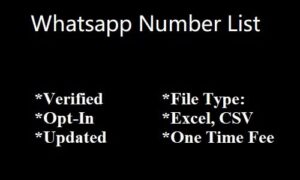WhatsApp, as a popular messaging app, offers a range of features that enable users to stay connected with friends, family, and colleagues. While it is known for its efficient data usage, understanding the average data consumption is essential for users to manage their data plans effectively. In this article, we explore the typical data usage of WhatsApp and how users can optimize their data usage.
Text Messaging:
Heading: Text Messaging
Sending and receiving text messages on WhatsApp is incredibly data-efficient. Plain text messages are small in size, consuming minimal data. Users can comfortably exchange text messages without Japan Whatsapp number Data significantly impacting their data usage.
Multimedia Messaging:
Heading: Multimedia Messaging
WhatsApp allows users to share various multimedia content, such as photos, videos, and voice messages. While multimedia messages may use more data compared to text messages, WhatsApp employs data compression techniques to minimize data consumption. However, sending and receiving large media files may still lead to higher data usage.
Voice Calls:
Heading: Voice Calls
WhatsApp’s voice calling feature is an affordable alternative to traditional phone calls. Voice calls made through WhatsApp use Voice over Internet Protocol (VoIP) technology, which requires a stable internet connection. While voice calls are generally data-efficient, users should be mindful of using them over cellular data, especially if they have limited data plans.
Video Calls:
Heading: Video Calls
WhatsApp’s video calling feature enables face-to-face communication with contacts. Video calls utilize more data than voice calls due to the transmission of real-time video content. Users should connect to a Wi-Fi network when making video calls to avoid excessive data consumption.
Status Updates and Stories:
Heading: Status Updates and Stories
WhatsApp’s “Status” feature allows users to share updates and stories with their contacts. While these updates are not sent directly to individuals, they are still uploaded and downloaded when viewed. Regularly posting and viewing status updates can contribute to data usage over time.
Auto-Download Settings:
Heading: Auto-Download Settings
WhatsApp provides users with control over media auto-download settings. By default, media files, such as photos and videos, are automatically downloaded when connected to Wi-Fi. Users can choose to customize these settings to avoid automatic downloads over mobile data, reducing Asia Email List data usage significantly.
Data Saver Mode:
Heading: Data Saver Mode
WhatsApp offers a “Data Saver” mode that users can activate to reduce data consumption further. This mode restricts media downloads and enables manual download of media content. Users can enable Data Saver mode in the app’s settings.
Conclusion:
In conclusion, WhatsApp is generally data-efficient for text messaging, but multimedia content, voice and video calls, and frequent status updates can contribute to data usage. Users can optimize their data consumption by managing auto-download settings, using Wi-Fi for data-intensive activities, and activating the Data Saver mode. By understanding their average data usage on WhatsApp, users can strike a balance between staying connected and managing their data plans effectively.

